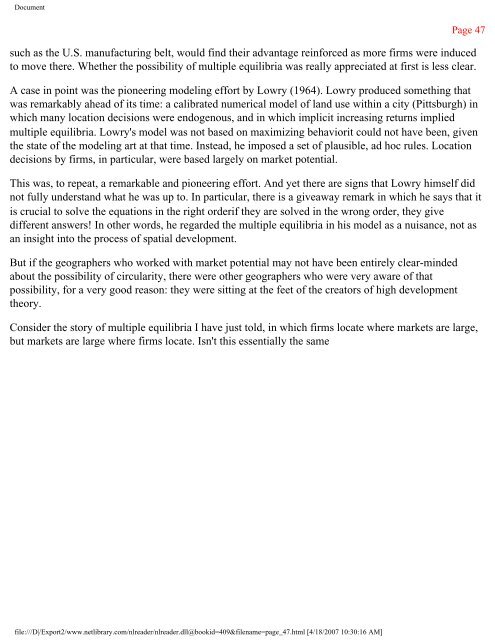Document file:///D|/Export1/www.netlibrary.com/nlreader/nlreader.dll ...
Document file:///D|/Export1/www.netlibrary.com/nlreader/nlreader.dll ...
Document file:///D|/Export1/www.netlibrary.com/nlreader/nlreader.dll ...
You also want an ePaper? Increase the reach of your titles
YUMPU automatically turns print PDFs into web optimized ePapers that Google loves.
<strong>Document</strong><br />
Page 47<br />
such as the U.S. manufacturing belt, would find their advantage reinforced as more firms were induced<br />
to move there. Whether the possibility of multiple equilibria was really appreciated at first is less clear.<br />
A case in point was the pioneering modeling effort by Lowry (1964). Lowry produced something that<br />
was remarkably ahead of its time: a calibrated numerical model of land use within a city (Pittsburgh) in<br />
which many location decisions were endogenous, and in which implicit increasing returns implied<br />
multiple equilibria. Lowry's model was not based on maximizing behavior it could not have been, given<br />
the state of the modeling art at that time. Instead, he imposed a set of plausible, ad hoc rules. Location<br />
decisions by firms, in particular, were based largely on market potential.<br />
This was, to repeat, a remarkable and pioneering effort. And yet there are signs that Lowry himself did<br />
not fully understand what he was up to. In particular, there is a giveaway remark in which he says that it<br />
is crucial to solve the equations in the right order if they are solved in the wrong order, they give<br />
different answers! In other words, he regarded the multiple equilibria in his model as a nuisance, not as<br />
an insight into the process of spatial development.<br />
But if the geographers who worked with market potential may not have been entirely clear-minded<br />
about the possibility of circularity, there were other geographers who were very aware of that<br />
possibility, for a very good reason: they were sitting at the feet of the creators of high development<br />
theory.<br />
Consider the story of multiple equilibria I have just told, in which firms locate where markets are large,<br />
but markets are large where firms locate. Isn't this essentially the same<br />
<strong>file</strong>:///<strong>D|</strong>/Export2/<strong>www</strong>.<strong>netlibrary</strong>.<strong>com</strong>/<strong>nlreader</strong>/<strong>nlreader</strong>.<strong>dll</strong>@bookid=409&<strong>file</strong>name=page_47.html [4/18/2007 10:30:16 AM]
















